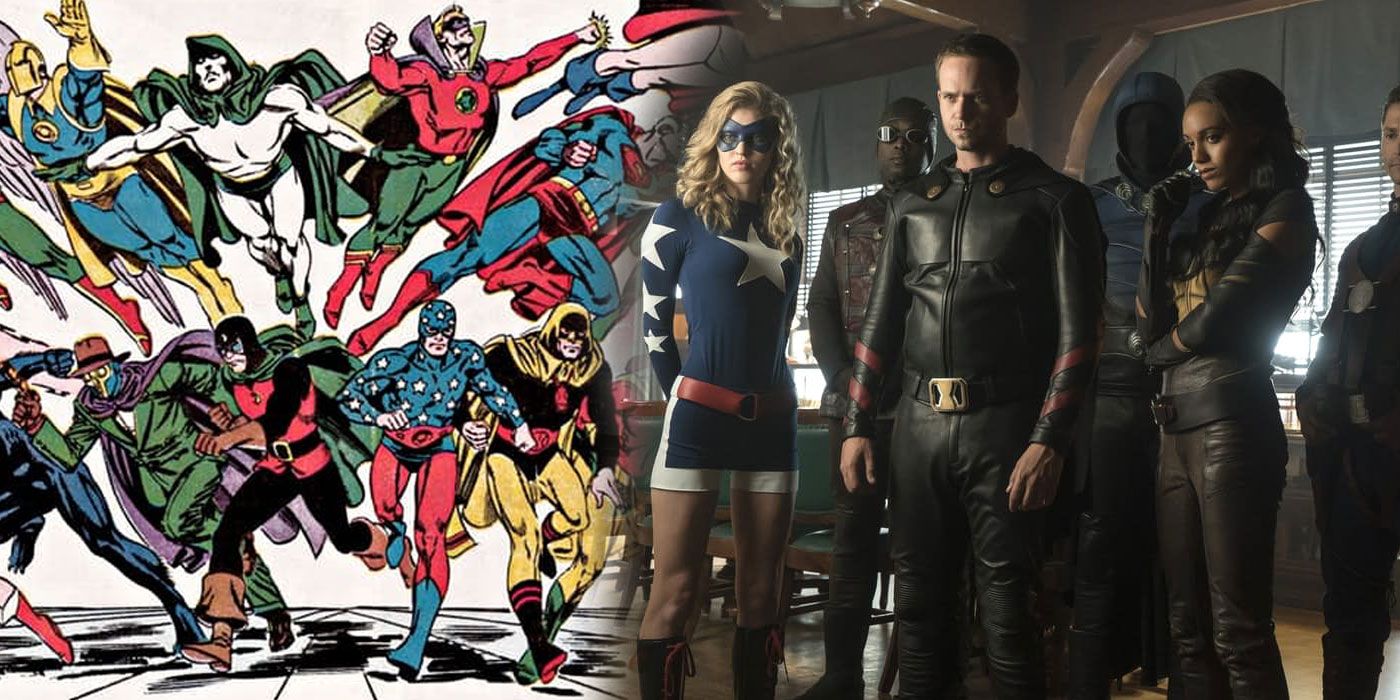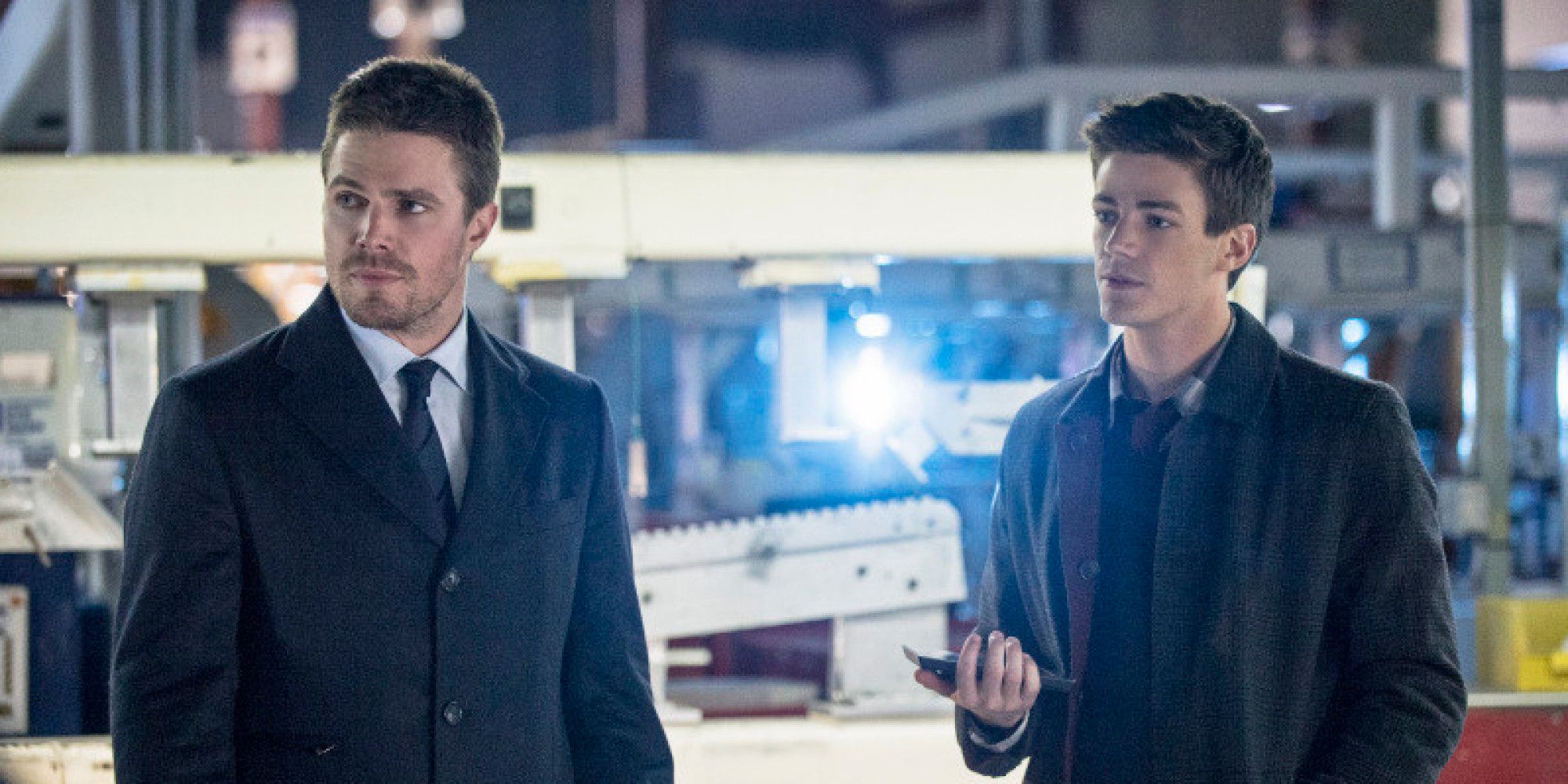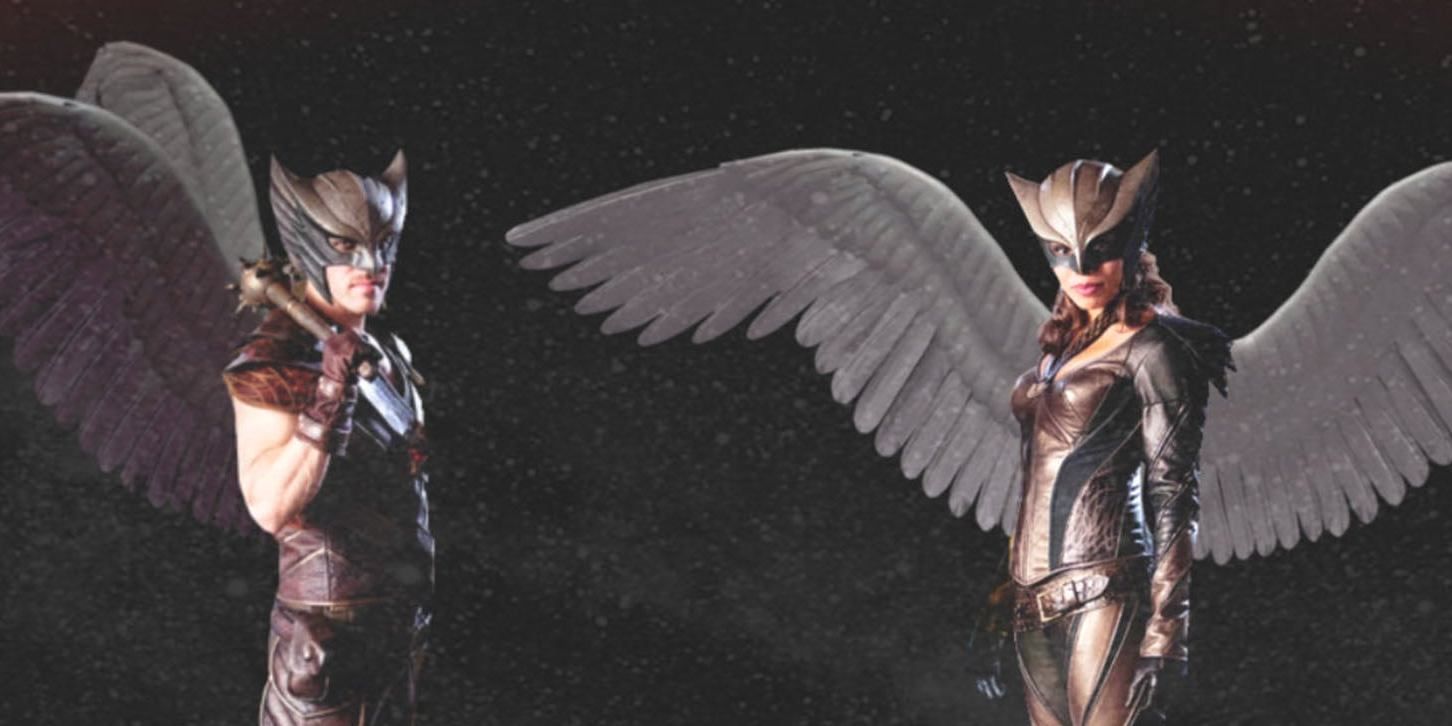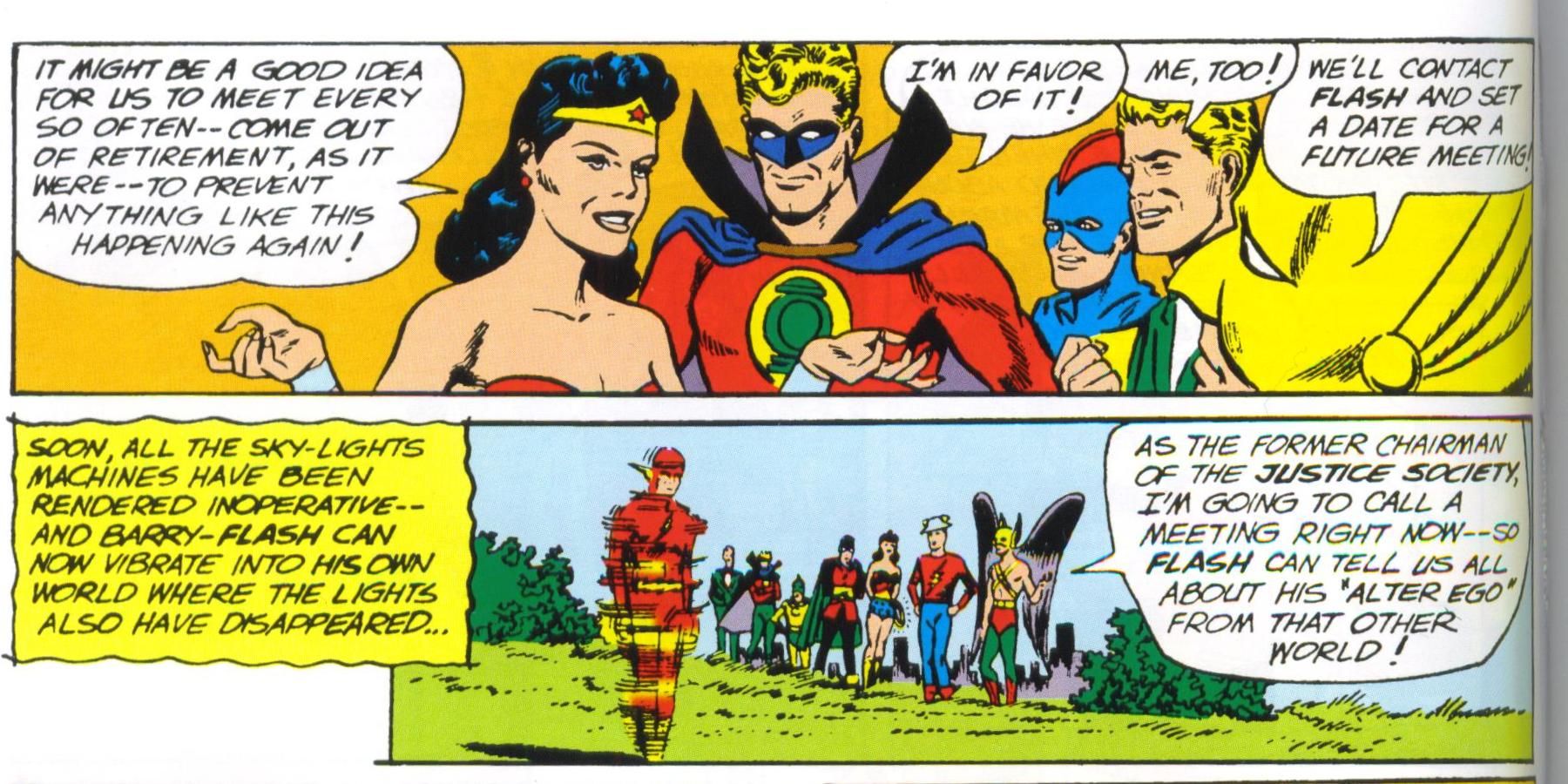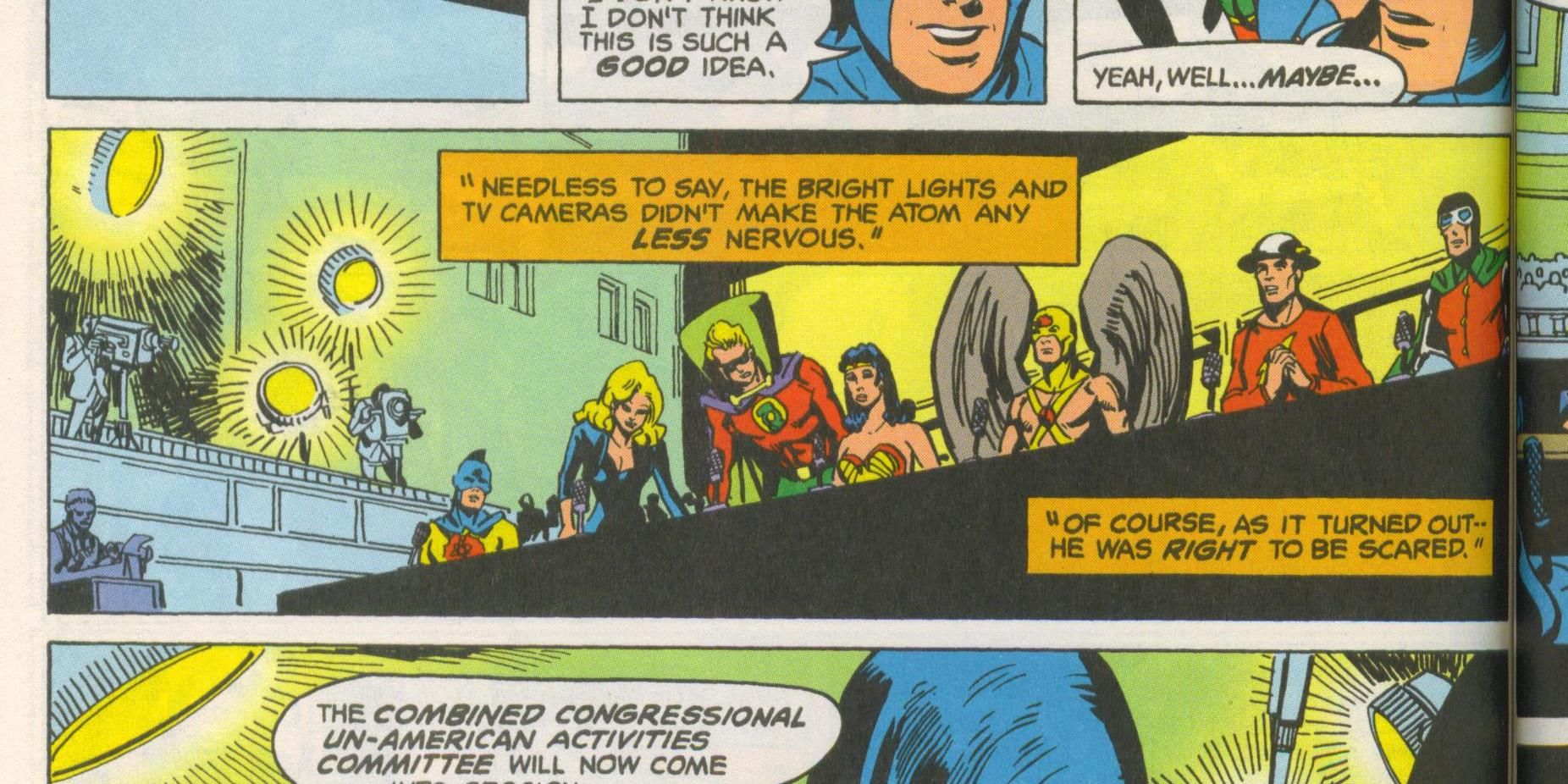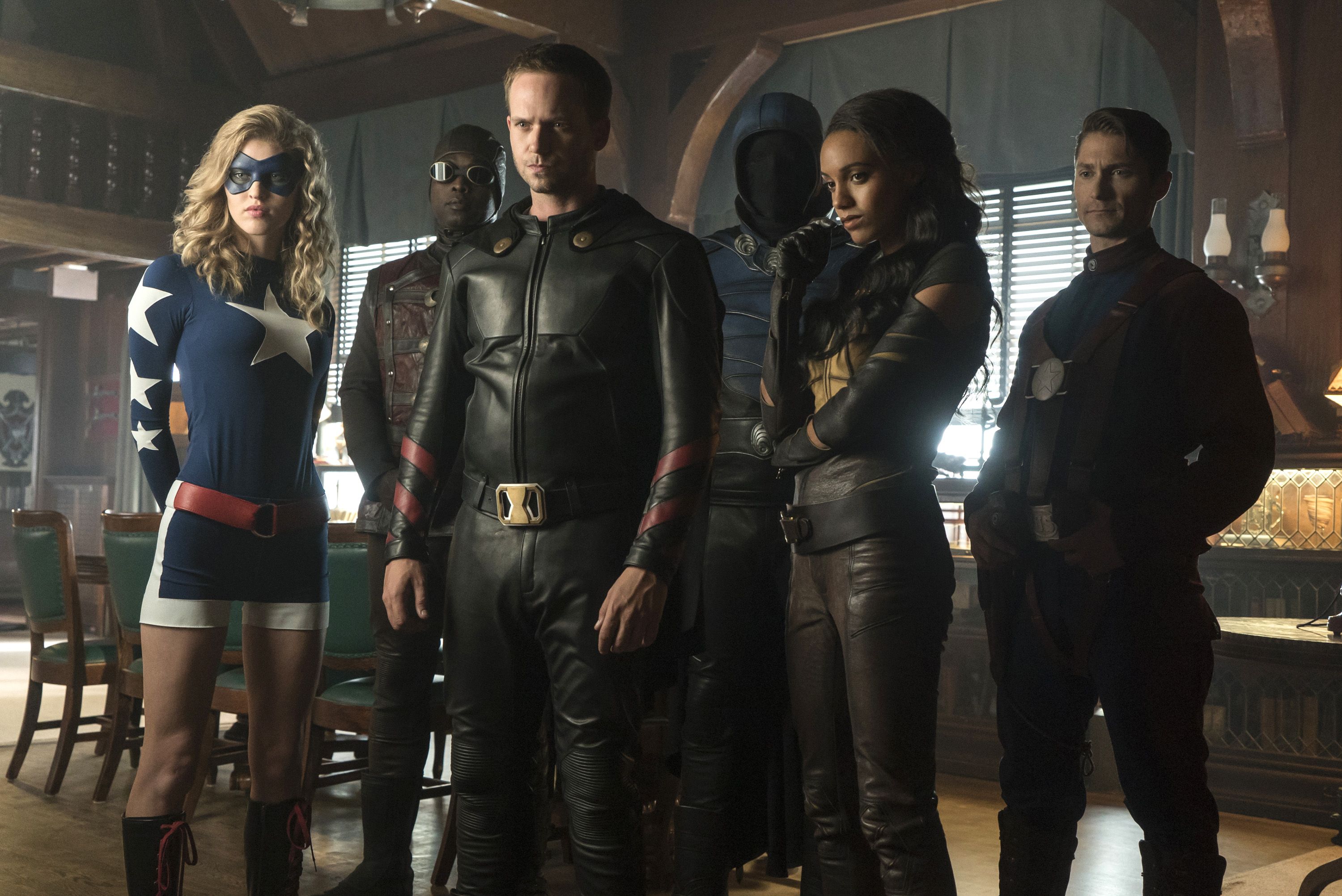The time-traveling format of "DC's Legends Of Tomorrow" spans all of the publisher's history, and there's no more historically important DC group than the Justice Society of America. As comics' first superhero team, the JSA brought together established solo stars like the Flash, the Green Lantern, Wonder Woman, Hourman and Hawkman. It created a template for everyone, from the All-Winners Squad and Seven Soldiers of Victory to the Justice League, Teen Titans, Avengers and Defenders.
RELATED: Sorry, Rip, Legends of Tomorrow’s Getting a New Leader
Nevertheless, when the JSA appears in earnest on this season of "Legends of Tomorrow," it will be a historical curiosity. "Arrow," the show which started DC's shared televisual universe, wasn't too keen on super-powered people, or even proper masks and codenames. Obviously that's changed -- a lot -- but it's one thing to grow a super-population and another to say it had been there all along. It's also possible that time-travel shenanigans, including "Flashpoint"-related meddling or the Legends' own involvement, were part of the JSA's origins. Thus, today we'll examine how "Legends" might explain the existence of a heretofore-unknown super-team.
"ARROW" GOES META
First, a bit of perspective. There are now four full seasons of "Arrow" (over episodes, by the time you read this), two of "The Flash" (around 50 episodes) and slightly less than a full season of "Legends" (17 episodes). That's a total of 159 hours, and about seven seasons' worth, of Arrowverse television. However, it only took "Arrow" about 30 episodes to get to its first real metahuman.
"Arrow" started acknowledging DC's more fantastic elements in a two-parter early in Season Two. "The Scientist" and "Three Ghosts" (episodes 8 and 9) guest-starred Barry Allen and featured a version of Cyrus Gold, known better to DC fans as the reanimated monster Solomon Grundy. Unlike his more mystical four-color origins, this Gold's super-strength and super-toughness came from the Mirakuru serum. (In what for our purposes is a happy accident, "Mirakuru" -- introduced in "The Scientist" along with its creator, Anthony Ivo -- sounds like a corruption of "Miraclo," the pill which gave the classic JSA's Hourman an hour's worth of super-abilities.) Co-written by Geoff Johns, the episodes were loaded with comics references. Among other things, they connected Malcolm Merlyn to Ra's al-Ghul; described the super-speed battle on the night Barry's mom was murdered; and ended with Barry giving Oliver an actual mask.
RELATED: New Legends of Tomorrow Trailer Teases 4-Way Crossover with Supergirl
Of course, "Three Ghosts'" biggest comic-book moment was showing Barry being hit by lightning and doused in chemicals. As a result, "The Flash" started off by grounding most of its metahumans either in that STAR Labs accident or in other isolated incidents. From there it was just a matter of time and storytelling space before the two shows produced enough super-people to field a team-oriented spinoff.
Still, while the Arrowverse has a lot more super-folks now, that doesn't necessarily speak to a longer metahuman history -- and especially not to the sort of generational development the Justice Society implies. All things being equal, the historical JSA most likely occupies the space between what the early "Arrow" and "Flash" episodes were willing to show and what we've learned subsequently about the Arrowverse's backstory.
In fact, if we're counting Mirakuru-enhanced fighters as metahumans (or close enough), "Arrow" retconned that status into the background of Deathstroke, Season Two's main villain. Flashbacks revealed that Ollie and company gave Slade Wilson a dose of Mirakuru to save his life. Consequently, present-day Slade could replicate the drug using samples of his own blood.
Accordingly, "Arrow's" choices in this area may not speak so much to conscious omissions as shifts in focus. Clearly the two-parter was testing the waters for a potential "Flash" series, and to do that it had to open up the universe to actual super-powers. Eventually the flashbacks also delved more into the supernatural, especially with Season Four's magic-idol quest paralleling Ollie's present-day fight against Damien Dahrk. Prior to that, though, Season Three's Ra's al-Ghul mega-plot introduced the Lazarus Pit (something the Christopher Nolan Batman movies didn't do), which revived both Thea Queen and Sara Lance. During Sara's rehab, Ollie then revealed his friendship with John Constantine. That last bit might have been Constantine's only appearance on "Arrow," but it's part of Ollie's backstory now and forevermore.
Speaking of Constantine, I'm not quite willing to shoehorn all of his short-lived NBC show into the Arrowverse. From what I can tell the two weren't supposed to fit together, and I'm not sure it would have made a difference either way.
FOUNDATIONS
That's because "Legends," appropriately enough, has laid a decent amount of groundwork for the existence of superpowers through DC history. Most prominent, naturally, are the reincarnation-prone Hawkgirl and Hawkman and their tormentor Vandal Savage. As far as the TV versions are concerned, the trio goes back to ancient Egypt, where meteorite exposure made them effectively immortal. Since part of the Hawks' reincarnation schtick involves re-learning how to fly, fight, etc., it seems like they had to have done all those things in previous lives. That would mean there were at least two superheroes in the pre-Arrow Arrowverse, even if they weren't part of a larger superheroic culture.
Another example of a pre-Arrow vigilante is Starling City's own Ted "Wildcat" Grant. Introduced in "Arrow's" third season as Laurel Lance's boxing trainer, Ted revealed that he became a vigilante to help clean up his neighborhood, and retired before Oliver Queen's return. Therefore, if Starling City can have a little-remembered vigilante, perhaps there's room for a little-remembered super-team.
(By the way, it may be just a series of coincidences, but it's still pretty cool that all these "forerunners" -- the Hawks, Wildcat, even the Hourman reference -- lead back to Justice Society members.)
Both Marvel and DC's shared superhero-movie universes have dealt with the superhero-history issue. Although 2008's "Iron Man" treated its headliner as if he were the first such costumed character, both it and its sequel offered glimpses of a prototypical Captain America shield. For whatever it's worth, a deleted scene from 2008's "Incredible Hulk" also included a glimpse of Cap frozen in Arctic ice, which didn't square with the ending of 2011's "Captain America: The First Avenger." Of course, "First Avenger" established Cap's primacy rather firmly, and related him specifically to Iron Man through Howard Stark's wartime exploits. "Ant-Man" then showed Henry Pym and Janet Van Dyne's careers as Cold War-era SHIELD agents in super-suits. For its part, "Batman v. Superman" went even further, depicting a Batman who'd been fighting crime for twenty years and a Wonder Woman who was active in World War I but vanished for the better part of a century.
To be sure, the two film series each started with the idea of building to their respective A-list super-teams. By contrast, "Arrow's" first season seemed content to remind viewers of Nolan and company's relatively-grounded Batman movies. That made it harder for "Arrow" to allow for the existence of super-powers; but the show seems to have adjusted fairly well.
FINDING A PLACE FOR THE JSA
Every superhero movie has to deal with the same narrative hurdle: getting its audience to accept its main character's fantastic nature. This is the "you'll believe a man can fly" question. Once that's accomplished, in order to set up a super-team or even a shared universe, moviemakers have to deal with two more concerns. First, will the audience accept more than one super-powered character; and second, how does the existence of super-powered people change the in-universe society?
In the beginning, "Arrow" was a series about a very grumpy archer who dressed in a green hood, smeared some greasepaint around his eyes, and skulked around rooftops and warehouses plunking arrows into criminals. For the most part, that wasn't hard to accept. The "Scientist"/"Three Ghosts" two-parter then asked audiences to believe in a super-serum which made ordinary bruisers into powerhouses. (It also implicitly asked them to believe in the super-speed effects of Barry's chemical bath, but not for a while.) Since Cyrus Gold basically just got stronger and tougher, that probably wasn't too hard either; and it became easier still once Roy Harper and Slade Wilson started throwing people around with Mirakuru-enhanced muscles.
Still, it took "The Flash's" upbeat tone to answer the second concern about super-powered people and the in-universe society. Early in its first season Joe West and Harrison Wells discussed Nora Allen's murder from the perspective of people whose experiences with metahumans began with the particle-accelerator accident. (Imagine a similar conversation taking place in the world of "Supergirl," where super-powered people and extraterrestrials have been a lot more common for a lot longer.) This analysis isn't really fair to "The Flash," because at that point I doubt anyone was thinking of the implications of a wartime Justice Society; but it does hint at the difficulties of retroactive continuity. If the JSA had been a prominent part of the Arrowverse's World War II, Wells certainly could have used them as a distraction: "There were super-people in the '40s, so maybe one of them killed Barry's mom. It certainly had nothing to do with me or someone borrowing this body -- wait, did I say that last part out loud?"
Actually, if we take the new "Legends" trailer at face value, it sounds like Ray Palmer both knows about the JSA and admires them. His lines might have been edited together, but apparently he refers to them as "the single greatest secret force this country's ever known." While there's room for debate about how "secret" they are if Ray Palmer's a fan, the point is that he does know. (His knowledge also argues against the JSA being from a parallel Earth.) How to square that with the anti-vigilante attitude which greeted the proto-Green Arrow in "Arrow" Season One?
Well, in the old days there were two roads to the JSA's retirement. We might call the first "natural causes," since as far as readers knew they just stopped being superheroes for various reasons. In 1962's seminal "Flash of Two Worlds," Barry Allen's visit to Earth-Two brought Jay Garrick back to active duty after eleven years (when Jay would probably have been in his early forties); and a year later ("Flash" #137), the two Flashes then freed Jay's colleagues from Vandal Savage's clutches.
The second factor sheds more light on the first. According to December 1979's "Adventure Comics" #466, in 1951 the JSA was hauled before a spy-hunting congressional committee. Asked to unmask or face prosecution, they chose instead to vanish. That story was intended to close the book on the JSA's Golden Age adventures, since it explained where the JSA went after its last "All-Star Comics" adventure (issue #57, cover-dated February-March 1951). Like the rest of the JSA's Golden Age exploits, the 1951 date has been a pretty firm one, establishing that the group operated for about ten years.
Originally, the JSA reunited in 1963, when "Flash" #137 was published and the revelation of Earth-Two was still fairly recent. However, when Earth-Two joined DC's main Earth-One as an ongoing concern, it became incorporated into DC's overall elastic timeline. In other words, the current comics always took place in "the present," while historical events like Barry Allen's electrochemical bath had no specific date. Even so, the JSA's Golden Age adventures were exempt; so as the years went by, events which depended on Earth-One characters grew more distant from those Greatest Generation exploits. This was also the case after -- and was perhaps exacerbated by -- "Crisis On Infinite Earths" merging everything into a single timeline. Thus, like Captain America's frozen slumber, the JSA's heyday only grew more distant from the present. If "Legends" still wants to have a wartime JSA which retired in the early '50s, it will be looking back on them from a gulf of at least 65 years.
Of course, with time travel the Legends can (and apparently will) team up with the JSA in its prime, as well as visit the present-day group. There's also the possibility that the Legends' involvement leads to the Justice Society's creation, resulting in one of those effects-before-causes time loops which give fans so many headaches. Again, the main question is how believable the JSA is as an historical entity.
In this respect the timeline helps the JSA's cause. Using the comics' dates for simplicity's sake, let's say the JSA formed in 1941 and operated into 1951, paralleling its comics run. Ten years fighting evil isn't insignificant, but their "secret" nature and the passage of all that time might have made them a curiosity, like the wartime UFOs which Army Air Corps pilots dubbed "foo fighters." Clearly the term "foo fighter" isn't impenetrably obscure, but neither is it common knowledge. In fact, it may be less-known today than it was 15 or 20 years ago, at the height of the "other" Foo Fighters' popularity.
At the risk of digressing too much, let's just say "Legends" has some options when it comes to the JSA, and they include both a period adventure with the originals and a more contemporary one with their successors. Ever since its Silver Age revival, the Justice Society has been a legacy-oriented group, whether that legacy was reflected in its Justice League counterparts or in its more direct successors. While the JLA are supposed to be the best of the best, Earth's first line of defense, etc., they and everyone else still look to the JSA's example. That distinguishes the JSA from other super-groups, but it also means the JSA need to occupy a particular place in their shared universe's history.
IN CONCLUSION
We'll know more as the season unfolds, but for now I'm kind of skeptical that "Legends" can integrate a classic, wartime version of the Justice Society into the Arrowverse without a little bit of timey-wimey assistance. The more I think about it, the more likely it seems that the Legends themselves will help the JSA stay relatively obscure. Revelations about super-powers in the Arrowverse have been gradual and measured, even with "Flash" opening the floodgates. Here's hoping that the finished product will be entertaining enough to forgive any awkward narrative mechanics.

